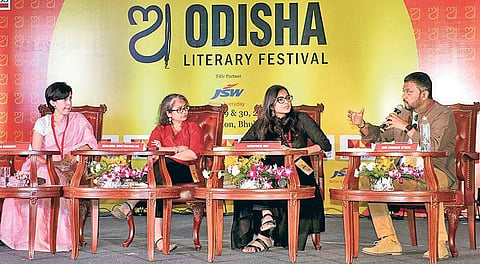

BHUBANESWAR: Do women represent women? It’s a reasonable question. One of the arguments for why we need more women in politics is to improve the representation of female populace, so there is already an assumption that women will be the best representatives of other women. But, in a world where women face injustices galore - from sexual harassment to tampon tax, from glass ceilings to pension poverty, it is not hard to identify common causes.
Throughout history, women have had different experiences at different times. Some past societies had women who were warriors, powerful priestesses, and political leaders. But the accessible numbers are very disappointing, felt panelists speaking on “Women on Women: Are they the best fit?” at the Odisha Literary Festival 2018 here on Sunday. The session was moderated by Consulting Editor with The New Indian Express Ravi Shankar Etteth.
“Women represent just 0.5 per cent in all of recorded history, while it is only after pre-history there are more women representatives than men,” said Ira Mukhoty, author of Daughters of the Sun, quickly adding that men, however, still have the upper hand.
Questioning the way Draupadi is represented today, Mukhoty said even though Vyasa actually wrote Mahabharata with Draupadi at the centre of the epic, she is represented in a way that defeats her essential role.
“Draupadi is dealt with in a refreshingly new perspective, while her fiery personality is perhaps a reason and probably has more to do with what we think,” she reasoned. “She is acknowledged larger-than-life and has been presented to the public in heroic ways certainly, but in ways that belittle the complexity of her personality and the breadth of her achievement.”
Echoing similar sentiments, researcher-writer Manjima Bhattacharjya said, the way we look at women has to change - how we treat her and how we see her in general. Referring to her book, Mannequin: Working Women in India’s Glamour Industry, Bhattacharya said, “the often overlooked but basic fact is that modelling is a profession and that models are labouring bodies whose work needs to be valued. However, what is seen today is that sexual harassment has become the talk of B-town, the recent one being the Tanushree Dutta case.”
She added that women are not a homogeneous group and their lives are differentially impacted by forces of gender, social class, ethnicity, religion, kinship and tribal ties, among others.
At other times, strict expectations have been placed on women, with (male) writers portraying them as inferior to men. But to cut the long story short, Devapriya Roy, the writer of Indira said “Good writers write both men and women better thsn ordinary writer.” Answering to why she chose to write Indira, Roy said that even today there are more to Mrs Indira Gandhi than what was told to us.
“Some found that she undertook Emergency for the good, while others have a contrasting view. We wanted to put both points of view in the book through graphics and leave it up to the readers to choose which team to go for.”